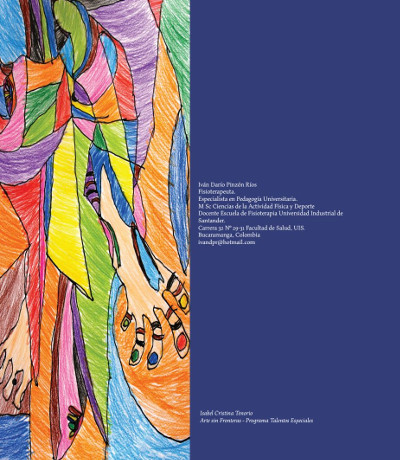Actualización en fibromialgia: Implicaciones neurofisiológicas y biomecánicas útiles para el abordaje fisioterapéutico
Contenido principal del artículo
Autores
Iván Darío Pinzón Ríosivandpr@hotmail.com
Resumen
La Fibromialgia es una patología reconocida como una condición común en la consulta de Fisioterapia y una causa importante de morbilidad a nivel mundial, que cada día va en aumento. Por ello es importante conocer las causas neurofisiológicas y biomecánicas relacionadas con esta enfermedad, para ser tenidas en cuenta en el tratamiento fisioterapéutico, siendo éste el objetivo del presente artículo de revisión. De su profundo análisis y comprensión se deriva una adecuada elección de las modalidades de tratamiento pertinentes para su manejo encaminado a disminuir el impacto de las limitaciones en las actividades funcionales o restricciones en los roles de estos pacientes.
Palabras clave:
Detalles del artículo
Licencia
Aquellos autores/as que tengan publicaciones con esta revista, aceptan los términos siguientes:
- Los autores/as conservarán sus derechos de autor y garantizarán a la revista el derecho de primera publicación de su obra, el cuál estará simultáneamente sujeto a la Licencia de reconocimiento de Creative Commons que permite a terceros compartir la obra siempre que se indique su autor y su primera publicación esta revista.
- Los autores/as podrán adoptar otros acuerdos de licencia no exclusiva de distribución de la versión de la obra publicada (p. ej.: depositarla en un archivo telemático institucional o publicarla en un volumen monográfico) siempre que se indique la publicación inicial en esta revista.
- Se permite y recomienda a los autores/as difundir su obra a través de Internet (p. ej.: en archivos telemáticos institucionales o en su página web) antes y durante el proceso de envío, lo cual puede producir intercambios interesantes y aumentar las citas de la obra publicada. (Véase El efecto del acceso abierto).
Los autores que publican en la revista se acogen al código de licencia de Creative Commons Atribución 4.0 Internacional (CC BY 4.0)




Referencias
Alegre, C., García, J., Tomas, M.L., Gómez, J.M., Blanco, E., Gobbo,M., et al. (2010). Documento de Consenso interdisciplinar para el tratamiento de la Fibromialgia. Acta Española de Psiquiatría,38(2), 108-120.
Alfano, A.P., Taylor, A.G., Foresman, P.A., Dunkl, P.R, McConnell, G.G.,Conaway, M.R., et al. (2001). Static magnetic fields for treatment of fibromyalgia: a randomized controlled trial. Journal Alternative and Complement Medicine, 7(1), 53-64.
Altan, L., Korkmaz, N., Bingol, U. & Gunay, B. (2009). Effect of Pilates training on people with fibromyalgia syndrome: a pilot study. Archives of Physical Medicine and Rehabilitation, 90, 1983-1988.
Ammer, K., & Melnizky, P. (1999). Medicinal baths for treatment of generalized Fibromyalgia. Forsch Komplementarmed, 6(2), 80-85.
Ang, D.C., Kaleth, A.S., Bigatti, S., Mazzuca, S., Saha, C., Hilligoss, J.,et al. (2011). Research to encourage exercise for Fibromyalgia (REEF): Use of motivational interviewing design and method. Contemporary Clinical Trials, 32(1), 59-68.
Aparicio, V.A., Ortega, F.B., Carbonell-Baeza, A., Femia, P., Tercedor, P.,Ruiz, J.R., et al. (2012). Are there gender differences in quality of life and symptomatology between fibromyalgia patients? American Journal of Men ́s Health, 6(4), 314-319.
Arias, M. (2008). ¿Es la fibromialgia una enfermedad neurológica? Neurología, 23(9), 593-560.
Arnold, L.M. (2006). Biology and therapy of fibromyalgia New therapies in fibromyalgia. Arthritis Research Therapy, 8, 212-232.
Branco, J.C., Bannwarth, B., Failde, I., Abello, J., Blotman, F., Spaeth, M., et al. (2010). Prevalence of fibromyalgia: a survey in five European countries. Seminars in Arthritis and Rheumatism, 39(6), 448-453.
Buckelew, S.P., Conway, R., Parker, J., Deuser, W.E., Read, J., Witty, T.E., et al. (1998). Biofeedback/relaxation training and exercise interventions for fibromyalgia: a prospective trial. Arthritis Care & Research, 11(3), 196-209.
Busch, A.J., Webber, S.C., Brachaniec, M., Bidonde, J., Bello-Haas, V.D., Danyliw, A.D., et al. (2011). Exercise therapy for fibromyalgia. Current Pain and Headache Reports, 15(5), 358-367.
Busch, A.J., Barber, K.A., Overend, T.J., Peloso, P.M., & Schachter, C.L. (2007). Exercise for treating fibromyalgia syndrome. Cochrane Database Systematic Review, 17(4), 1-76.
Caballero, C.V. (2010). Fibromialgia. Conceptos para América Latina. Recuperado 29 Agosto de 2012, de: http://es.scribd.com/Carvicab/ d/33037068-Fibromialgia-Conceptos-actuales-2010#download.
Cardenas, C. & Ruiz, J. (2014). Efecto de un programa de actividad física en pacientes con fibromialgia: revisión sistemática. Medicina Clínica (Barcelona), 1-6.
Carbonario, F., Matsutani, L.A., Yuan, S.L. & Marques, A.P. (2013). Effectiveness of high-frequency transcutaneous electrical nerve stimulation at tender points as adjuvant therapy for patients with fibromyalgia. European Journal of Physical and Rehabilitation Medicine, 49(2), 197-204.
Carville, S.F., Arendt-Nielsen, S., Bliddal, H., Blotman, F., Branco, J.C., Buskila, D., et al. (2007). EULAR evidence based recommendations for the management of fibromyalgia syndrome. Annals of Rheumatic Disease, 1-26.
Castel, A., Cascón, R., Padrol, A., Sala, J. & Rull, M. (2012). Multicomponent cognitive-behavioral group therapy with hypnosis for the treatment of Fibromyalgia: Long-Term Outcome. Journal of Pain, 13(3), 255-265.
Castro-Sánchez, A,M,, Matarán-Peñarrocha, G.A., Arroyo-Morales, M.,Saavedra-Hernández, M., Fernández-Sola, C. & Moreno-Lorenzo,C. (2011a). Effects of myofascial release techniques on pain, physical function, and postural stability in patients with fibromyalgia: a randomized controlled trial. Clinical Rehabilitation, 25(9), 800-813.
Castro-Sánchez, A.M., Matarán-Peñarrocha, G.A., Sánchez-Labraca, N., Quesada-Rubio, J.M., Granero-Molina, J. & Moreno-Lorenzo, C. (2011b). A randomized controlled trial investigating the effects of craniosacral therapy on pain and heart rate variability in fibromyalgia patients. Clinical Rehabilitation. 25(1), 25-35. Castro-Sánchez, A.M., Matarán-Peñarrocha, G.A., Granero-Molina, J.,
Aguilera-Manrique, G., Quesada-Rubio, J.M. & Moreno-Lorenzo, C.(2011c). Benefits of massage-myofascial release therapy on pain, anxiety, quality of sleep, depression, and quality of life in patients with fibrom yalgia. Evidence Based Complement Alternative Medicine, 2011, 1-9.
Branco, J.C., Bannwarth, B., Failde, I., Abello, J., Blotman, F., Spaeth,M., et al. (2010). Prevalence of fibromyalgia: a survey in five European countries. Seminars in Arthritis and Rheumatism, 39(6), 448-453.
Buckelew, S.P., Conway, R., Parker, J., Deuser, W.E., Read, J., Witty, T.E., et al. (1998). Biofeedback/relaxation training and exercise interven- tions for fibromyalgia: a prospective trial. Arthritis Care & Research, 11(3), 196-209.
Busch, A.J., Webber, S.C., Brachaniec, M., Bidonde, J., Bello-Haas, V.D., Danyliw, A.D., et al. (2011). Exercise therapy for fibromyalgia. Current Pain and Headache Reports, 15(5), 358-367.
Busch, A.J., Barber, K.A., Overend, T.J., Peloso, P.M., & Schachter, C.L. (2007). Exercise for treating fibromyalgia syndrome. Cochrane Databa- se Systematic Review, 17(4), 1-76.
Caballero, C.V. (2010). Fibromialgia. Conceptos para América Latina. Recuperado 29 Agosto de 2012, de: http://es.scribd.com/Carvicab/d/33037068-Fibromialgia-Conceptos-actuales-2010#download.
Cardenas, C. & Ruiz, J. (2014). Efecto de un programa de actividad física en pacientes con fibromialgia: revisión sistemática. Medicina Clínica (Barcelona), 1-6.
Carbonario, F., Matsutani, L.A., Yuan, S.L. & Marques, A.P. (2013). Effectiveness of high-frequency transcutaneous electrical nerve stimulation at tender points as adjuvant therapy for patients with fibromyalgia. European Journal of Physical and Rehabilitation Medicine, 49(2), 197-204.
Carville, S.F., Arendt-Nielsen, S., Bliddal, H., Blotman, F., Branco, J.C.,Buskila, D., et al. (2007). EULAR evidence based recommendations for the management of fibromyalgia syndrome. Annals of Rheumatic Disease, 1-26.
Castel, A., Cascón, R., Padrol, A., Sala, J. & Rull, M. (2012). Multicomponent cognitive-behavioral group therapy with hypnosis for the treatment of Fi- bromyalgia: Long-Term Outcome. Journal of Pain, 13(3), 255-265.
Castro-Sánchez, A,M,, Matarán-Peñarrocha, G.A., Arroyo-Morales, M., Saavedra-Hernández, M., Fernández-Sola, C. & Moreno-Lorenzo, C. (2011a). Effects of myofascial release techniques on pain, physical function, and postural stability in patients with fibromyalgia: a randomized controlled trial. Clinical Rehabilitation, 25(9), 800-813.
Castro-Sánchez, A.M., Matarán-Peñarrocha, G.A., Sánchez-Labraca,N., Quesada-Rubio, J.M., Granero-Molina, J. & Moreno-Lorenzo, C.(2011b). A randomized controlled trial investigating the effects of craniosacral therapy on pain and heart rate variability in fibromyalgia patients. Clinical Rehabilitation. 25(1), 25-35.
Castro-Sánchez, A.M., Matarán-Peñarrocha, G.A., Granero-Molina, J., Aguilera-Manrique, G., Quesada-Rubio, J.M. & Moreno-Lorenzo, C. (2011c). Benefits of massage-myofascial release therapy on pain, anxiety,quality of sleep, depression, and quality of life in patients with fibromyalgia. Evidence Based Complement Alternative Medicine, 2011, 1-9.
Cedraschi, C., Desmeules, J., Rapiti, E., Baumgartner, E., Cohen, P., Finckh, A., et al. (2004). Fibromyalgia: a randomized controlled trial of a treatment programme based on self-management. Annals of Rheumatic Disease, 63, 290–296.
Chaitow, L. (1995). Fibromyalgia and Muscle Pain. Thorsons Pub, 1-205.Chaves, D. (2013). Actualización en Fibromialgia. ASOCOMEFO, 30(1), 83-88. Chong, Y.Y. & Ng, B.Y. (2009). Clinical aspects and management of Fibromyalgia Syndrome. Annals Academy of Medicine Singapore, 38, 967-973. Congreso de la República de Colombia. Ley 528 Por la cual se reglamenta el ejercicio de la profesión de Fisioterapia, se dictan normas en materia de ética profesional y otras disposiciones. Diario Oficial No. 43711 de 20 de Septiembre de 1999.
Contreras, N.A. & Tamayo, R.V. (2005). Fibromialgia aspectos clínico-prácticos del diagnóstico y tratamiento. Médica Sur, 12(2), 93-98. Culpepper, L. (2010). Evaluating the patient with fibromyalgia. Journal Clinical Psychiatry, 71(9), e25.
Da Cunha Ribeiro, R.P., Roschel, H., Artioli, G.G., Dassouki, T., Perandini, L.A., Calich, A.L., et al. (2011). Cardiac autonomic impairment and chronotropic incompetence in fibromyalgia Arthritis Research & Therapy, 13, 190-195.
Deluze, C., Bosia, L., Zirbs, A., Chantraine, A. & Vischer, T.L. (1992).Electroacupuncture in fibromyalgia: results of a controlled trial. British Medical Journal, 305(6864), 1249-1252.
Derbyshire, S.W.G., Whalley, M.G. & Oakley, D.A. (2009). Fibromyalgia pain and its modulation by hypnotic and non-hypnotic suggestion: An fMRI analysis. European Journal of Pain, 13, 542–550.
Dijkstra, A., Vlaeyen, J.W., Rijnen, H. & Nielson, W. (2001). Readiness to adopt the self-management approach to cope with chronic pain in fibromyalgic patients. Pain, 90(1-2), 37-45.
Dupree, K., Adams, D., Winters-Stone, K. & Burckhardt, K.S. (2006). A comprehensive review of 46 exercise treatment studies in fibromyalgia (1988–2005). Health and Quality of Life Outcomes, 4, 67-72.
Esteban, B. (2012). Manejar el dolor de manera integral. Publicado 11 de Septiembre de 2012 Vanguardia.com. Recuperado 28 Septiembre de 2012, de: http://www.vanguardia.com/vida-y-estilo/salud/173703-manejar-el-dolor-de-manera-integral.
Evcik, D., Kizilay, B. & Gokcen, E. (2002). The effects of balneotherapy on fibromyalgia patients. Rheumatology International, 22(2), 56-59.
Fernández de las Peñas, C., Cano Monsalve, G.E., Carravilla Blanco, C., Barrio Lorenzo, L. & Jerez Martín, M.L. (2004). Opinión de los profesionales sanitarios en relación al tratamiento actual en síndrome fibromiálgico. Fisioterapia y calidad de vida 7(3), 5-12.
Forseth, K.O. & Gran, J.T. (2002). Management of Fibromyalgia what are the Best Treatment Choices? Drugs, 62(4), 577-592.
Gauffin, J., Hankama, T., Hannonen, P., Kautiainen, H., Pohjolainen, T. & Haanpää, M. (2013). Do fibromyalgia patients use active pain management strategies? A cohort study. Journal of Rehabilitation Medicine,45(5), 477-480.
Gronemann, S.T., Ribel-Madsen, S., Bartels, E.M., Danneskiold-Samsoe,B. & Bliddal, H. (2004). Collagen and muscle pathology in fibromyalgia patients. Rheumatology(Oxford), 43(1), 27-31.
Guedj, E., Cammilleri, S., Niboyet, J., Dupont, P., Vidal, E., Dropinski, J.P.,et al. (2008). Clinical correlate of brain SPECT perfusion abnormalities in Fibromyalgia. Journal of Nuclear Medicine. 49(11), 1798-1803.
Gunther, V., Mur, E., Kinigadner, U. & Miller, C. (1994). Fibromyalgia the effect of relaxation and hydrogalvanic bath therapy on the subjective pain experience. Clinical Rheumatology, 13(4), 573-578.
Häkkinen, A., Häkkinen, K., Hannonen, P. & Alen, M. (2001). Strength training induced adaptations in neuromuscular function of premenopausal women with fibromyalgia: comparison with healthy women. Annals of Rheumatic Disease, 60(1), 21-26.
Hernández, J.J. & Moreno, C. (2008). Fibromialgia en la mujer. Asociación Colombiana para el Estudio del Dolor ACED, 197-214. Hurtado, Y. (2012) El 80% de los casos de fibromialgia en mujeres es subdiagnósticado. Periódico electrónico CronicadelQuindio.com. Publicado 13 de Marzo de 2012. Recuperado 19 Octubre de 2012, de: http://www.cronicadelquindio.com/noticia-completa-titulo-el_80__de_los_casos_de_fribromialgia_en_mujeres_es_subdiagnosticado-seccion-general-nota-43868.htm
Imamura, M., Cassius, D.A. & Fregni, F. (2009). Fibromyalgia: From treatment to rehabilitation. European Journal of Pain, 3(2), 117-122.
Ingber, D.E. (2008). Tensegrity and Mechanotransduction. Journal of Bodywork and Movement Therapies, 12(3), 198-200.
Jahan, F., Nanji, K., Qidwai, W. & Qasim, R. (2012). Fibromyalgia Syndrome: An overview of pathophysiology, diagnosis and management. Oman Medical Journal, 27(3), 192-195.
Jones, K.D., Burckhardt, C.S., Clark, S.R., Bennett, R.M. & Potempa,K.M. (2002). A randomized controlled trial of muscle strengthening versus flexibility training in fibromyalgia. Journal of Rheumatology,29(5), 1041-1048.
Jones, K.D., Burckhardt, C.S., Deodhar, A.A., Perrin, N.A., Hanson, G.C. & Bennett, R.M. (2008). A six-month randomized controlled trial of exercise and pyridostigmine in the treatment of fibromyalgia. Arthritis & Rheumatism, 58, 612-622.
Kaada, B. (1989). Treatment of fibromyalgia by low-frequency transcutaneous nerve stimulation. Tidsskr Nor Laegeforen, 109(29), 2992-2995.
Kalichman, L. (2010). Massage therapy for fibromyalgia symptoms. Rheumatology International, 30(9), 1151-1157.
Karper, W.B., Jannes, C.R.& Hampton, J.L. (2006). Fibromyalgia syndrome: the beneficial effects of exercise. Rehabilitation Nursing, 31(5), 193-198. Kayo, A.H., Peccin, M.S., Sanches, C.M. & Trevisani, V.F. (2012).Effectiveness of physical activity in reducing pain in patients with fibromyalgia: a blinded randomized clinical trial. Rheumatology International,32(8), 2285-2292.
Latash, M.L. (1998). Neurophysiological Basis of Movement. Editorial Human Kinetics. Lee, K. (2006). Historia de la Fibromialgia. Recuperado 03 Mayo de 2012, de:http://chronicfatigue.about.com/od/fibromyalgia/p/historyfm.htm.
Light, K.C., White, A.T., Tadler, S., Iacob, E. & Light, A.R. (2012). Genetics and Gene Expression Involving Stress and Distress Pathways in Fibromyalgia with and without Comorbid Chronic Fatigue Syndrome. Pain Research and Treatment, 1-13.
Little, K.E. (1969). Toward more effective Manipulative management if chronic myofascial strain and stress syndromes. Journal American Osteopathic Association, 68, 675-685.
Mannerkorpi, K., Nyberg, B., Ahlmen, M. & Ekdahl, C. (2000). Pool exercise combined with an education program for patients with fibromyalgia syndrome. A prospective, randomized study. The Journal ofRheumatology, 27(10), 2473-2481.
Maquet, D., Demoulin, C., Croisier, J.L. & Crielaard, J.M. (2007). Benefits of physical training in fibromyalgia and related syndromes. Annales de réadaptation et de médecine physique, 50, 363–368.
Martin, D.P., Sletten, C.D., William, B.A. & Berger, I.H. (2006). Improvement in Fibromyalgia Symptoms with Acupuncture: Results of a Randomized Controlled Trial. Mayo Clinic Proceedings, 81(6), 749-757.
Martinez-Lavin, M., Leon, A., Hermosillo, A.G., Pineda, C. & Amigo, M.C. (1999). The dysautonomia of fibromyalgia may simulate lupus. Journal of Clinical Rheumatology, 5, 332-334.
Martinez-Lavin, M., Hermosillo, A.G., Rosas, M. & Soto, M.E. (1998). Circadian studies of autonomic nervous balance in patients with fibromyalgia. A heart rate variability analysis. Arthritis & Rheumatology, 41(11), 1966-1971.
Metzger, D., Zwingmann, C., Protz, W. & Jackel, W.H. (2000). Whole-body cryotherapy in rehabilitation of patients with rheumatoid diseases pilot study. Rehabilitation, 39(2), 93-100.
Millea, P. & Holloway, R. (2000). Treating Fibromyalgia. American family physician, 1575-1582.
Moretti, F.A., Ezequiel, R., Marvulle, V., Pollak, D.F. & Riera, R. (2011). Assessing knowledge on Fibromyalgia among internet users. Revista Brasileira Reumatologia, 51(1), 7-19.
Neumann, L., Sukenik, S., Bolotin, A., Abu-Shakra, M., Amir, M., Flusser, D. & Buskila, D. (2001). The effect of balneotherapy at the Dead Sea on the quality of life of patients with fibromyalgia syndrome. Clinical Rheumatology, 20(1), 15-19.
Nijs, J., Mannerkorpi, K., Descheemaeker, F. & Van Houdenhove, B.(2010). Primary care physical therapy in people with fibromyalgia: opportunities and boundaries within a monodisciplinary setting. Physical Therapy. 90(12), 1815-1822.
Offenbacher, M. & Stucki, G. (2000). Physical therapy in the treatment of fibromyalgia. Scandinavian journal of rheumatology, 113, 78-85.
Olsen, N.J. & Park, J.H. (1998). Skeletal muscle abnormalities in patients with Fibromyalgia. American Journal of Medical Sciences, 315(6), 351-363.
Paoletti, S. (2004). El papel de los tejidos en la mecánica humana. 3a Edición. Editorial Paidotribo: Barcelona.
Pearl, S.J., Lue, F., MacLean, A.W., Heslegrave, R.J., Reynolds, W.J. & Moldofsky, H. (1995). The effects of bright light treatment on the symptoms of fibromyalgia. Journal of Rheumatology, 23(5), 896-902.
Perrot, S. (2008). Fibromyalgia syndrome: a relevant recent construction of an ancient condition? Current Opinion Support Palliative Care, 2(2),122-127.
Pilat, A. (2003). Terapias Miofasciales: Inducción Miofascial. Editorial McGraw-Hill / Interamericana de España, S.A.
Podolecki, T., Podolecki, A. & Hrycek, A. (2009). Fibromyalgia: pathogenetic,diagnostic and therapeutic concerns. Pol Arch Med Wewn, 119(3), 157-161.
Ramsay, C., Moreland, J., Ho, M., Joyce, S., Walker, S. & Pullar, T. (2000).An observer-blinded comparison of supervised and unsupervised aerobic exercise regimens in fibromyalgia. Rheumatology (Oxford), 39(5), 501-505.
Rivera, J., Alegre, C., Nishishinya, M.B. & Pereda, C.A. (2006). Evidencias terapéuticas en Fibromialgia. Reumatol Clin, 2(1), 34-37.
Rubio, J. & Paredes, J.A. (2004). Fibromialgia. Propuesta de modelo fisiopatológico fascial. Madrid, España: Editorial U San Pablo CEU.
Sañudo, B., Galiano, D., Carrasco, L. & de Hoyo, M. (2010). Evidencias para la prescripción de ejercicio físico en pacientes con fibromialgia. Revista Andaluza de Medicina del Deporte, 3(4),159-169.
Schiltenwolf, M., Häuser, W., Felde, E., Flügge, C., Häfner, R., Settan, M., et al. (2008). Physiotherapy, exercise and strength training and physical therapies in the treatment of fibromyalgia síndrome. Schmerz,22(3), 303-312.
Sluka, K.A. (2012). Mechanism and management of pain for the Physical Therapist. 1th Edition. IASP Press: Seattle.
Smith-Agreda, V. & Ferres-Torres, E. (2004). Principios de anatomofisiopatología. Editorial Paidotribo: Barcelona.
Smith, H.S., Harris, R. & Clauw, D. (2011). Fibromyalgia: An Afferent Processing Disorder Leading to a Complex Pain Generalized Syndrome. Pain Physician, 14, 217-245.
Sprott, H., Salemi, S., Gay, R.E., Bradley, L.A., Alarcón, G.S., Oh, S.J., et al. (2004). Increased DNA fragmentation and ultrastructural changes in fibromyalgic muscle fibres. Annals of the Rheumatic Diseases, 63(3), 245-251.
Sumpton, J,E, & Moulin, D.E. (2008). Fibromyalgia: Presentation and management with a focus on pharmacological treatment. Pain Respiratory Management, 13(6), 477-483.
Thomas, E., Missounga, L. & Blotman, F. (2006) Fibromialgia. Kinesiterapia y Medicina física, 1-7.
Tovar, M.A. (2005). Fibromialgia. Colombia Médica, 36(004), 287-291.
Villagrán, J.M., Páez, M., Campo, F., Pérez, J. & Salaberri, J. (2000). Aspectos psicopatológicos de la Fibromialgia, Archivos de Psiquiatria, 63(2), 159-182.
Watson, N.F., Buchwald, D., Goldberg, J., Noonan, C. & Ellenbogen, R.G.(2009). Neurologic signs and symptoms in Fibromyalgia. Arthritis & Rheumatism, 60(9), 2839-2844.
White, A. The fibromyalgia syndrome. (1995). Electroacupuncture is a potentially valuable treatment. BMJ, 310(6991),1406.Wolf, M. (2009). Historia de la Fibromialgia. Recuperado 27 Septiembre de 2012, de: http://fibromialgico.blogspot.com/2009/03/historia-de-la-fibromialgia.html
Wolfe, F., Clawn, D.J., Fitzcharles, M.A., Goldenberg, D.L., Katz, R.S.,Mease, P., et al. (2010). The American College of Rheumatology preliminary diagnostic criteria for Fibromyalgia and measurement of symptom severity. Arthritis Care & Research, 62, 600-610.
Wolfe, F., Smythe, H.A., Yunus, M.B., Bennett, R.M., Bombardier, C., Goldenberg, D.L., et al. (1990). The American College of Rheumatology 1990 criteria for the classification of fibromyalgia: report of the Multicenter Criteria Committee. Arthritis & Rheumatology, 33, 160-172.


 PDF
PDF
 XML
XML










